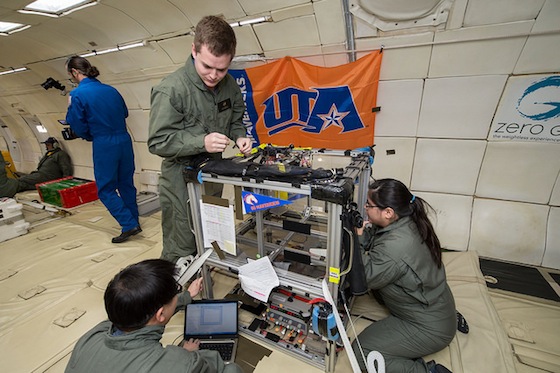Wireless Strain Sensing System for Space Structural Health Monitoring
PI: Haiying Huang, University of Texas - Arlington
PI: Haiying Huang, University of Texas - Arlington

- TA12 Materials, Structures, Mechanical Systems and Manufacturing
The ongoing demand of the integrated space Vehicle Health Monitoring Systems (VHMS) has been boosted by the increasing global interests in space exploration. Specifically, the wireless sensor has the benefit of reducing the payload and the launch costs. Thus, lots of researchers monitor the fundamental structural physical indicators, i.e. the strain, to study the spacecraft mechanical performance.
The flight opportunity is expected to advance the current payload TRL level from TRL 4 to TRL 6.
The system features ultra-low power consumption, completely wireless sensing, solar powering, and portability. The proposed system includes a wireless strain sensor that consumes about 6 mW, a wireless solar energy harvesting unit, a frequency modulation/demodulation unit, and a Data Acquisition Unit (DAQ). To achieve such an ultra-low power operation, a voltage-controlled oscillator (VCO) is used to convert the direct-current (DC) strain signal to a high frequency oscillatory signal. Next, this oscillatory signal is transmitted by an unpowered wireless transponder. A generic solar panel with energy harvesting circuit is used to power the strain sensor node for a short period of time. The frequency demodulation will be implemented as a frequency counter implemented in a microcontroller board (Arduino) and acquired using a PC-based MATLAB program.

During the flight, a battery-less wireless strain sensing system, designed to remotely monitor the structure deformation (strain) under external loads, was able to provide quality strain measurements. Two types of experiments were conducted without difficulties: static measurement and dynamic vibration tests. The sensor’s functionality in both experiments were calibrated and verified under various gravitational environments, i.e. Martian, Lunar, and Zero. The wireless sensing system maintained normal functionality during the flights without observing any radio frequency interferences.
The static tests were carried out using a simple device that deforms the free end of a metallic cantilevered beam at various levels. The wirelessly received sensing signals displayed excellent linear strain - deflection relationships for all three gravity conditions. Additionally, the strain measurement between 0g to 1.8g shows consistent measurements at the same loading condition. These results verify the robustness of the sensor in various gravitational environments.
The dynamic tests were performed by installing the sensor on a vibrating metal plate. The method is proven to generate reliable and measurable vibration in all gravitational environments. The dynamic results demonstrate the capability of the sensor to wirelessly measure the time-dependent strain variations.
The mature wireless strain sensing system is intended to provide accurate and reliable static strain or vibration measurements via a low power and wireless method. The intended application is in structural health monitoring of space infrastructure. The technology readiness level (TRL) measures the maturity of technologies during developmental stages. Prior to the flights, the payload was in TRL 4. The successful parabolic flight test has advanced the payload to TRL 5 by verifying the sensor functionality in relevant space environment, i.e. various gravity levels.
The results obtained during the flights have verified the sensor’s capability: the sensor is capable of measure static strain in satisfactory range and can acquire dynamic vibration strain signal at real-time. The sensor is supported by elements as required by the hardware description of TRL 5: a solar energy harvester, which powers the sensor continuously assume it has access to a light source or sun light. The flight test also provided insights on how to partially modify the software architecture to better capture the vibration measurements. Through this flight test opportunity, the sensor multiplexing issues can now be addressed in TRL 6.
Technology Details
-
Selection DateAFO6 (Jun 2013)
-
Program StatusCompleted
- 1 Parabolic
Development Team
-
PIHaiying Huang
-
Organization
-
SponsorUniversity of Texas, Arlington
-
More Information

